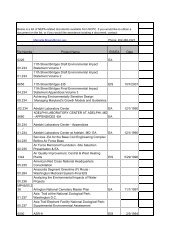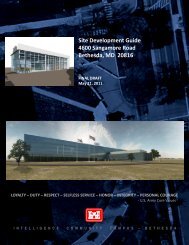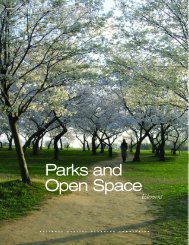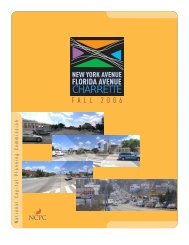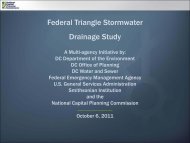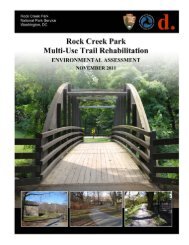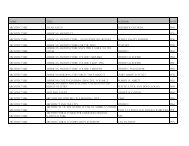Tetratech Interior Drainage Study for Potomac Park - National ...
Tetratech Interior Drainage Study for Potomac Park - National ...
Tetratech Interior Drainage Study for Potomac Park - National ...
You also want an ePaper? Increase the reach of your titles
YUMPU automatically turns print PDFs into web optimized ePapers that Google loves.
MEMORANDUMshown on Exhibit 2 includes a ponding area south of the main pond that identifies the ponding at thesouth limit of the tunnel. It should be noted that the analysis per<strong>for</strong>med does not consider storage withinthe tunnel.Scenario 3 – pump dischargeIn this simulation the total runoff from a 100-year storm was routed down to the Federal Triangle. Nodiversion of flow through the combined sewer system in the watershed was considered. The pumpingcapacity of the O Street pump station was used to drain the ponded areas. Based on the design capacity ofthe pump station, a constant pumping rate of 500 MGD was used. The river stage was assumed to be atthe 100-year level at which time the gravity drain outlet has negligible impact on the pond elevation. Themaximum elevation of the ponded interior in this scenario is 7.6 feet NAVD88; the footprint of the area isshown on the map included as Exhibit 3.It should be noted that 3 tunnel entrances are located within the identified interior drainage area or northof the area. This will allow water to enter the tunnels and be conveyed to the south. The inundation areashown on Exhibit 3 includes a ponding area south of the main pond that identifies the ponding at thesouth limit of the tunnel. It should be noted that the analysis per<strong>for</strong>med does not consider storage withinthe tunnel.An assumption made in this analysis is that the full pumping capacity of the O Street pump station isavailable to drain the Federal Triangle area which is part of the B / NJ combined sewer. However, asshown in the schematic of the system (included in Appendix A) B St /NJ also drains a large area upstreamof the Federal Triangle. The upstream system includes many other pump stations and combined seweroverflow points. Previous modeling ef<strong>for</strong>ts made by WASA indicate that during the 100-year stormevent, the pipes downstream of the Federal Triangle are conveying 900+ cfs. This indicates that thepumps cannot fully keep up with the total flow in the system and some ponding would be expected. Thisscenario provides another possible inundation limit that could results under certain pumping operations.However its likely that the pumps would be partially (rather than full) used to drain the Federal Trianglearea. This would indicate that a realistic interior pond that accounts <strong>for</strong> the pumping as the only pondoutlet is between the one shown in this scenario (7.6 feet) and Scenario 1 (9.4 feet) where no pumping isconsidered.Scenario 4 – gravity drainThis scenario is a joint probability analysis that looks at a range of rainfalls on the interior and the abilityof the Constitution Avenue drain (the gravity drain outlet) to discharge from the Federal Triangle areabased on a range of river stages in the <strong>Potomac</strong> River. High stages on the <strong>Potomac</strong> River impact theinterior flooding only at the Constitution Avenue gravity drain outlet. This outlet includes a closurestructure so flow from the river cannot backup into the Federal Triangle area; however during high riverstage, the interior would need to pond to a sufficient depth to create enough hydraulic head to <strong>for</strong>ce flowthrough this drain. The details of the joint probability analysis are included in Appendix C. A review ofthe results shows that the stage of the river has little impact on the elevation of the pond interior. Thissame conclusion was reached in the 1992 Corps study. Based on the analysis of this scenario, the interiorpond elevation that has a 1% probability of occurring is 9.3 feet NAVD88; the footprint of the area isshown on the map included as Exhibit 4.No direct benefit of the pumping station is considered in this scenario. However an indirect benefitconsidered is that the pumping capacity will provide enough relief to the combined sewers that nosurcharging of the B St / NJ Avenue line will occur through the Federal Triangle area.It should be noted that 3 tunnel entrances are located within the identified interior drainage area or northof the area. This will allow water to enter the tunnels and be conveyed to the south. The inundation areashown on Exhibit 4 includes a ponding area south of the main pond that identifies the ponding at the8



